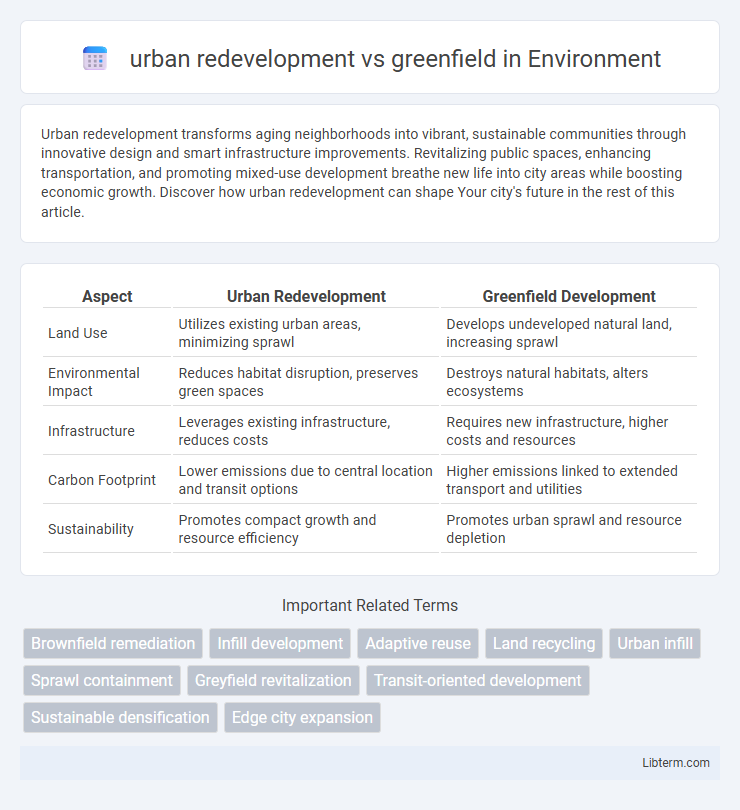Urban redevelopment transforms aging neighborhoods into vibrant, sustainable communities through innovative design and smart infrastructure improvements. Revitalizing public spaces, enhancing transportation, and promoting mixed-use development breathe new life into city areas while boosting economic growth. Discover how urban redevelopment can shape Your city's future in the rest of this article.
Table of Comparison
| Aspect | Urban Redevelopment | Greenfield Development |
|---|---|---|
| Land Use | Utilizes existing urban areas, minimizing sprawl | Develops undeveloped natural land, increasing sprawl |
| Environmental Impact | Reduces habitat disruption, preserves green spaces | Destroys natural habitats, alters ecosystems |
| Infrastructure | Leverages existing infrastructure, reduces costs | Requires new infrastructure, higher costs and resources |
| Carbon Footprint | Lower emissions due to central location and transit options | Higher emissions linked to extended transport and utilities |
| Sustainability | Promotes compact growth and resource efficiency | Promotes urban sprawl and resource depletion |
Introduction to Urban Redevelopment and Greenfield Development
Urban redevelopment transforms underused or deteriorated city areas into functional, vibrant spaces, improving infrastructure while preserving existing urban fabric. Greenfield development involves constructing new communities on previously undeveloped land, offering fresh planning opportunities but often requiring significant environmental and infrastructural investment. Both approaches shape urban growth, balancing economic, social, and environmental priorities.
Defining Urban Redevelopment: Concepts and Examples
Urban redevelopment involves repurposing or revitalizing existing urban areas to improve infrastructure, housing, and commercial spaces while preserving cultural and historical assets. Examples include transforming old industrial zones into mixed-use developments or upgrading inner-city neighborhoods to enhance livability and economic activity. This approach contrasts with greenfield development, which focuses on building new projects on undeveloped land, often at the urban periphery.
Understanding Greenfield Development: Scope and Potential
Greenfield development entails constructing new infrastructure and communities on previously undeveloped land, typically agricultural or natural areas, offering vast opportunities for customized urban planning and expansion. This type of development allows for comprehensive design flexibility, including transportation systems, residential layouts, and commercial zones, often resulting in modern, efficient communities. However, it also carries environmental considerations, such as habitat disruption and increased resource consumption, which must be managed to balance growth and sustainability.
Environmental Impacts: Urban Redevelopment vs Greenfield
Urban redevelopment minimizes environmental impacts by reusing existing infrastructure, reducing land consumption, and preserving natural habitats compared to greenfield development, which often leads to habitat fragmentation, increased carbon emissions, and loss of agricultural land. Redevelopment projects leverage brownfield sites to remediate soil contamination and improve urban biodiversity, while greenfield projects contribute significantly to urban sprawl and impervious surface expansion, exacerbating stormwater runoff and heat island effects. Efficient urban redevelopment supports sustainable growth by enhancing resource utilization and protecting surrounding ecosystems from the detrimental effects associated with new greenfield construction.
Economic Considerations in Redevelopment and Expansion
Urban redevelopment maximizes land use efficiency by utilizing existing infrastructure, reducing costs associated with new utility installations and transportation networks. Greenfield development often incurs higher initial expenditures due to land acquisition, site preparation, and extension of services to previously undeveloped areas. Redevelopment projects may stimulate local economies by revitalizing communities, increasing property values, and attracting investment, whereas greenfield expansion can lead to economic growth but may also strain municipal resources.
Social Implications and Community Response
Urban redevelopment often fosters social inclusion by revitalizing existing neighborhoods and improving access to services, whereas greenfield development can lead to social fragmentation due to displacement or lack of established community ties. Community response to urban redevelopment typically involves active engagement and grassroots initiatives aiming to preserve cultural identity, while greenfield projects may face resistance stemming from concerns about environmental impact and loss of local heritage. Studies indicate that redevelopment projects with participatory planning processes result in higher community satisfaction and improved social cohesion compared to isolated greenfield developments.
Infrastructure Demands and Challenges
Urban redevelopment often faces significant infrastructure demands, including upgrading aging utilities, managing limited space, and integrating modern transportation systems into established layouts. Greenfield development allows for designing infrastructure from scratch, offering greater flexibility but requires extensive investment in basic utilities and connectivity. Both approaches present challenges: urban redevelopment must balance preservation with modernization, while greenfield projects contend with environmental impact and long lead times for infrastructure rollout.
Policy, Regulation, and Urban Planning Perspectives
Urban redevelopment policies prioritize revitalizing existing infrastructure through stringent zoning regulations and sustainability mandates to optimize land use efficiency and reduce urban sprawl. Greenfield development often faces regulatory challenges centered on environmental impact assessments and land preservation policies that aim to protect natural habitats and maintain regional ecological balance. Urban planning frameworks increasingly favor integrated approaches combining redevelopment incentives with greenfield controls to promote sustainable, resilient city growth aligned with long-term climate and social equity goals.
Case Studies: Successes and Failures
Urban redevelopment projects such as the High Line in New York City showcase successful transformation of abandoned infrastructure into vibrant public spaces, boosting local economies and community engagement. Conversely, greenfield developments like the sprawling suburbs around Phoenix, Arizona, highlight challenges including environmental degradation and increased reliance on automobiles. Case studies reveal that urban redevelopment often maximizes existing resources and infrastructure, whereas greenfield projects risk inefficient land use and greater ecological impact.
Future Trends in Sustainable City Growth
Urban redevelopment prioritizes the revitalization of existing infrastructure, reducing land consumption and preserving natural habitats, which aligns with sustainable city growth principles. Greenfield development often leads to increased urban sprawl, higher carbon emissions, and greater resource use, challenging long-term sustainability goals. Future trends emphasize mixed-use spaces, renewable energy integration, and smart technologies in urban redevelopment to foster resilient, eco-friendly communities.
urban redevelopment Infographic

 libterm.com
libterm.com